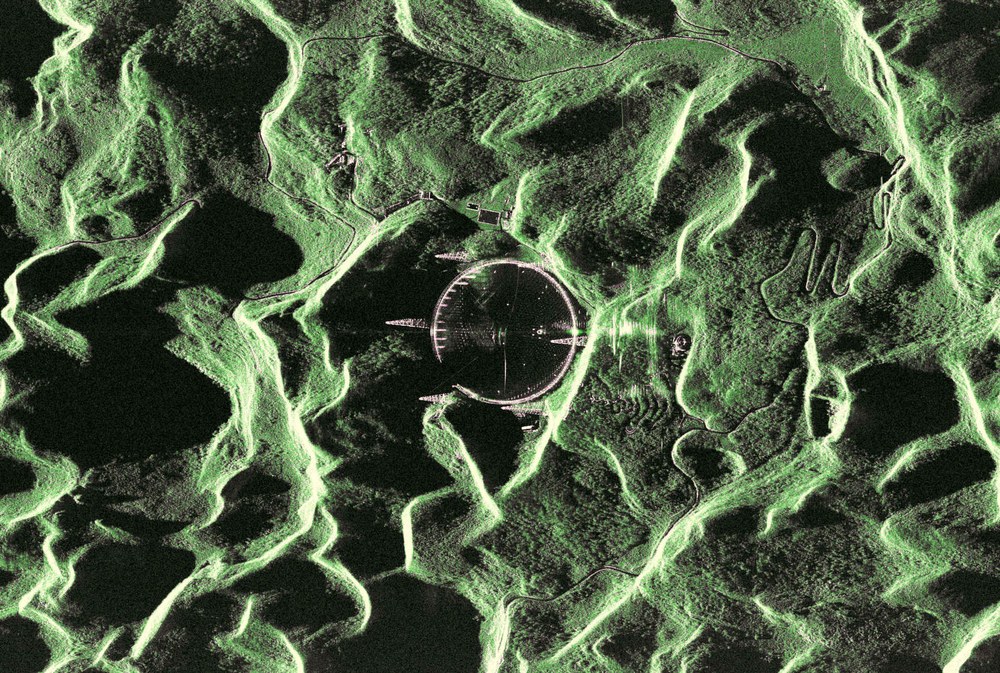Radio telescopes seen from space



- The June highlight images from the twin TerraSAR-X and TanDEM-X satellites show a selection of well-known radio telescope facilities.
- Focus: Space, Earth observation
Radio telescopes look deep into space to explore the secrets of the Universe. Using the radio waves received by these telescopes, astronomers can study interstellar gases, the remnants of supernovae, the Sun and much more. They are also used in the search for potential radio signals from intelligent extraterrestrial beings. Radio astronomy was founded by the US physicist Karl Guthe Jansky, who detected microwave radiation from the Milky Way for the first time in 1933. The first radio telescopes were built in the years following this discovery. Today, more than 100 radio telescopes around the world are being used to explore the vastness of the cosmos.
Sensitive telescopes with large apertures are needed to receive the radio waves emitted by distant astronomical objects. They are large enough that the radar satellites TerraSAR-X and TanDEM-X can be used to image the telescopes from space in great detail. Experts at the DLR Microwaves and Radar Institute have now collected and processed satellite images showing a number of radio telescopes.
At the heart of these telescopes are the antennas, which typically consist of large parabolic reflectors. The Chinese Five-hundred-meter Aperture Spherical Telescope (FAST), in the first image, is currently the largest radio telescope in the world, with a reflector diameter of 520 metres. This 'eye on the cosmos' was constructed in south-eastern China between 2011 and 2016 and operates at frequencies between 70 megahertz and three gigahertz.
Telescopes are usually built in remote areas in order to minimise interference caused by radio signals generated by human activity. The signals from television broadcasting and remote sensing satellites still reach the telescopes, but they transmit only in narrow and internationally recognised frequency bands and can thus easily be filtered out. The transmission frequencies of TerraSAR-X and TanDEM-X are far away from the frequency bands protected for radio astronomy and thus also do not interfere with observations.
The second image shows the Arecibo Observatory, hidden deep in the hills of Puerto Rico. It was built between 1960 and 1963, approximately 30 years after the foundation of radio astronomy. With a diameter of 305 metres, it long held the record for the radio telescope with the largest aperture. It facilitated observations in a frequency range of between 300 megahertz and 10 gigahertz, making it particularly well suited for the exploration of interstellar clouds (H I regions) and pulsars (rapidly rotating neutron stars). In August 2020, a steel cable stabilising one of the receiver platform suspension towers snapped. The observatory was abandoned in October 2022 following further damage to the facility and the reflector. The telescope is well known and has featured in a number of films, such as 'James Bond – GoldenEye' (1995) and 'Contact' (1997).
The digital elevation model in the third image shows the Very Large Array (VLA) located on the Plains of San Agustin in New Mexico, which lies at an altitude of more than 2000 metres. This radio interferometer consists of 27 individual radio telescopes, each 25 metres in diameter, that can be placed at different locations along the three tracks of the Y-shaped array. These three axes, each 21 kilometres long, are clearly visible in this satellite image.
TerraSAR-X and TanDEM-X are particularly well suited for observing changes on Earth's surface, as the data they acquire can be used to produce two- and three-dimensional images, respectively. These images feature high geometric resolution and are independent of weather conditions and the availability of daylight. Both satellites are used to generate high quality radar imagery for a variety of scientific, commercial and security applications.
About the mission
The TerraSAR-X and TanDEM-X missions were realised on behalf of the German Aerospace Center (Deutsches Zentrum für Luft- und Raumfahrt; DLR) with funding from the Federal Ministry for Economic Affairs and Climate Action (Bundesministerium für Wirtschaft und Klimaschutz; BMWK). They are the first German satellites to be realised within the framework of a Public Private Partnership (PPP) between DLR and Airbus Defence and Space GmbH. DLR is responsible for the construction and operation of the ground segment as well as for the scientific use of the data and its distribution to external researchers worldwide. Airbus Defence and Space GmbH contributed to the costs of developing, constructing and launching the satellites. The 'Geo-Intelligence' programme line at Airbus D&S is responsible for the commercial marketing of the data. Since 2016, the project has been continued under a follow-on agreement with Airbus.
